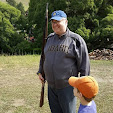But ultimately, those figures are for gaming. At some point, I've got to research a battle, set up my table to match the historical terrain, and play a game. And then I find that it really doesn't matter how many hours I've spent carefully shading the folds along the hemline of a figure's coat. With hundreds of figures on the table, the mass effect of the figures, rather than the quality of each, is what gives the game its visual appeal.
So even a basic block paint job looks great on the table, with one caveat; the table itself must look like a real place. Trees must look like trees. Roads must look like roads. And it must all work together.
Like everyone else, it seems, I started with felt terrain. I used a green felt cloth for my grass. Squares of tan felt represented fields. Large dark green ovals stood in for forests. And little strips of brown and blue indicated roads. This all works just fine for a game. But miniatures gaming is a visual hobby, and my lovingly painted figures just didn't look right on such representational terrain.
So a few years back I started a big initiative to create attractive terrain that was flexible enough to work on any battlefield. I wasn't going to sculpt terrain boards, but I did want good looking forests, fields, roads, and farms. I was gaming in 15mm only, so I bought everything for that scale. Buildings and fences are plentiful. If it exists in life, someone sells it for 15mm figures. I bought Woodland Scenics trees by the box full. I put Woodland Scenics dark brown ballast in a ketchup bottle, which I squeezed out for roads. I found the perfect mottled green fabric to build a battlefield on. I can now put on a great looking 15mm game, adapting my terrain to almost any time period or locale.
But two years ago the 25mm bug bit. Hard. I dabbled with Romans. I experimented with Vikings. I tried some lace wars. I dipped my big toe in the 25mm WW2 pool. By the time I started painting Napoleonics, I was hooked. I still enjoy 15mm figures, but the 25s have a visual appeal that the 15s just can't match.
When it came time to game with my 25mm figures, I hit a snag. My beautiful terrain just wouldn't work. I hated to do it, but I would have to buy some 25mm terrain. And here's the sticking point; all those pre-made 15mm terrain features just aren't produced for 25mm. Sure, I could find trees, and my ketchup bottle roads work equally well for 25mm, but man-made items? Fences and buildings? They just aren't available.
And so I have to scratch build my terrain. This blog entry shows the method I used yesterday to build some rail fences for ACW gaming.
I made a trip to my local Michael's for supplies: a big strip of basswood, sticks for fence rails, and tacky glue to hold it all together.
The skinny sticks are the key to this project. Long and thin, they will provide all the fencing material. The wood is pretty solid, about the texture and density of tongue depressors. This one bag is all I could ever need for my table. I figure it will make about 50' of fencing.
At 1/4", the skinny sticks are too wide to make convincing rails. Armed with my hobby knife, I did my best Abe Lincoln and split each stick down the middle. This was fiddly work, requiring a light touch and about 20 forceful cuts per stick. Once I split the rails, I used the hobby knife to cut the long strips in half for the fence rails. I cut them into 1" sections for the fence posts. One nice benefit of my process is that the cuts were irregular, following the grain on the wood. My miniature rails have all the twists and gnarls that real rails have.
I used a toothpick to apply the tacky glue to the rails, then glued the whole thing together. The first section was the hardest. Once I got the hang of it, I was able to assemble a 10.5" section of fence, with 20 separate parts, in about ten minutes. After the glue dried, I used big dollops of tacky glue to affix fences to strips of basswood. The finished product is very sturdy.
Real rail fences usually have five or six rails, but I could only fit three without making the fences over scale. To do more, I would have to have cut smaller strips, and the wood just wouldn't allow for that. The rail fences I've seen come up to about my nose, so a 1" height is just about perfect.
 Fenced Road
Fenced RoadThis method produced some good looking fences, almost perfectly in scale, and at a cost of pennies per section. Once I worked out my method, I was able to crank out three more sections in two hours, start to finish. Once painted, these fences should look great on the wargaming table.
Next I'll try some snake rail fences.
Next I'll try some snake rail fences.
















Thanks for sharing this. I'm going to try making some of these fences.
ReplyDeleteI'm slightly unhappy with the color of the static grass as it doesn't quite harmonize with my other terrain pieces but it'll do.
ReplyDeletechain link fence for sale